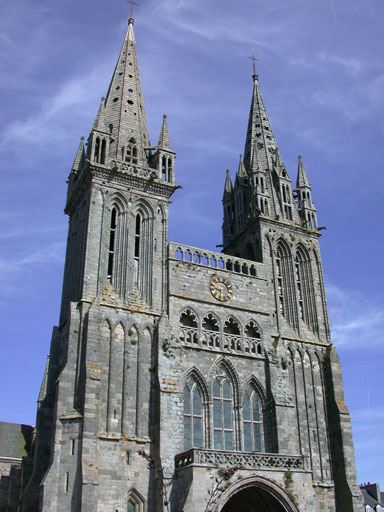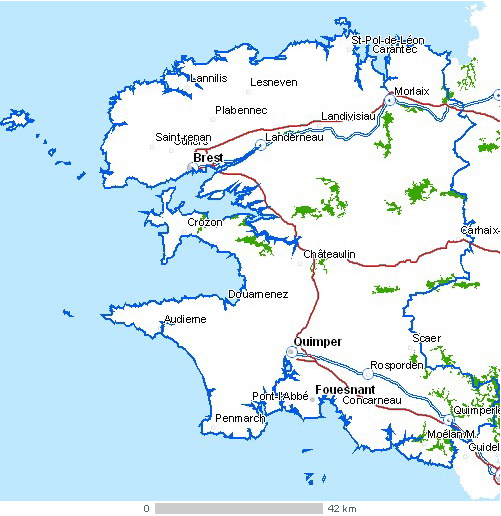|
Viscounty Of Léon
The Viscounty or County of Léon () was a feudal state in extreme western Brittany in the High Middle Ages. Though nominally a vassal of the sovereign duke of Brittany, Léon was functionally independent of any external controls until the viscounts came under attack by King Henry II of England. It thus became the focus of revolts and wars when Brittany was drawn into the Angevin empire. The history of Léon's early counts is obscure. The original viscounts of Léon were public officials appointed by the counts of Cornouaille, but by the mid-eleventh century they had usurped public authority in their province. Their ability to remain independent of both count and duke was likely due to their remoteness in the extremity of the Armorican peninsula. Unlike their Breton neighbours they did not participate in the Norman conquest of England in 1066.Everard, 16. Count Harvey II, however, did participate on the side of Stephen of Blois in the nineteen years of civil war in England ... [...More Info...] [...Related Items...] OR: [Wikipedia] [Google] [Baidu] |
France Pays Bretons Map
France (), officially the French Republic ( ), is a country primarily located in Western Europe. It also comprises of Overseas France, overseas regions and territories in the Americas and the Atlantic Ocean, Atlantic, Pacific Ocean, Pacific and Indian Oceans. Its Metropolitan France, metropolitan area extends from the Rhine to the Atlantic Ocean and from the Mediterranean Sea to the English Channel and the North Sea; overseas territories include French Guiana in South America, Saint Pierre and Miquelon in the North Atlantic, the French West Indies, and many islands in Oceania and the Indian Ocean. Due to its several coastal territories, France has the largest exclusive economic zone in the world. France borders Belgium, Luxembourg, Germany, Switzerland, Monaco, Italy, Andorra, and Spain in continental Europe, as well as the Kingdom of the Netherlands, Netherlands, Suriname, and Brazil in the Americas via its overseas territories in French Guiana and Saint Martin (island), ... [...More Info...] [...Related Items...] OR: [Wikipedia] [Google] [Baidu] |
Harvey I, Viscount Of Léon
Harvey I of Léon (c. 1068–aft. 1128) was a Viscount of Léon. Life Harvey I was the son of Guihomar II and the father of Guihomar III. "Harvey son of Guihomar of Léon" is said to have taken part to the First Crusade between 1096 and 1101 with Duke Alan IV Fergent. Harvey I founded the priory of Saint-Martin in Morlaix Morlaix (; br, Montroulez) is a commune in the Finistère department of Brittany in northwestern France. It is a sub-prefecture of the department. Leisure and tourism The old quarter of the town has winding streets of cobbled stones and overha ... on 3 March 1128. His son and successor Guihomar signed with him the foundation charter of the priory of Saint-Martin. André Chédeville & Noël-Yves Tonnerre ''La Bretagne féodale XIe-XIIIe siècles''. Ouest-France, Université Rennes (1987), p. 165. References Sources *Chaillou, Léa. ''The House of Léon: Genealogy and Origins''. Foundations: The Journal of the Foundation for Medieval Genealogy, v ... [...More Info...] [...Related Items...] OR: [Wikipedia] [Google] [Baidu] |
Guihomar II, Viscount Of Léon
Guihomar II de Léon (died in 1103) was a Viscount of Léon. He is said to have succeeded his grandfather Guihomar I. Origins Guihomar is said to be the son of a man named Ehuarn. But according to Joëlle Quaghebeur, this Ehuarn was actually a "Viscount from Cornouaille", that is to say a Viscount of Le Faou. It seems that Guihomar II succeeded his supposed grandfather and namesake Guihomar I. A charter of the Cartulary of Saint-Georges de Rennes also mentions a Guihomar, son of Alan, himself named son of Guihomar in another charter in the same cartulary. Guihomar might then be the son of Ehuarn and a daughter or a granddaughter of Guihomar I. Guihomar's death is mentioned in the ''Chronicon Britannicum''. It is specified that Guihomar II was killed in 1103 by his own subjects. Possible family tree Alan of Léon │ ├──> Guihomar I of Léon († after 1040) │ │ │ ├──> A ... [...More Info...] [...Related Items...] OR: [Wikipedia] [Google] [Baidu] |
Guihomar I, Viscount Of Léon
Guihomar I of Léon was one of the first Viscounts of Léon. He lived c. 970 - 1055. Life Léa Chaillou believes that he was born circa 970, the son of Alan de Léon, himself the son of a possible great-granddaughter of Alan I, King of Brittany. He is cited in 1021 and in 1034 or 1040. He is said to have owned estates in the Kemenet-Héboé in the Bishopric of Cornouaille. This rise in power threatened Alain Canhiart, the Count of Cornouailles, who was victorious in 1055 and gave the hamlet of Lezugar en Beuzec to the episcopal authority. Guihomar I was still alive at the time. Issue Guihomar is said to have had a son named Éhuarn but according to Joëlle Quaghebeur Ehuarn was actually a “Viscount from Cornouaille”, that is to say of a Viscount of Le Faou who married a woman belonging to the House of Léon. Chaillou attributes to him two sons, Alan II (c. 995–aft. 1060) and Alfred (d. aft 1060). Alan II had three children, Guihomar, Anne/Emma who married Odo I, Viscount ... [...More Info...] [...Related Items...] OR: [Wikipedia] [Google] [Baidu] |
Saint-Pol-de-Léon
Saint-Pol-de-Léon (; br, Kastell-Paol) is a commune in the Finistère department in Brittany in north-western France, located on the coast. It is noted for its 13th-century cathedral on the site of the original founded by Saint Paul Aurelian in the 6th century. It has kept a unique architecture, such as Notre-Dame du Kreisker Chapel, an 80 m high chapel, which is the highest in Brittany. It was also the scene of a battle during the Breton War of Succession, where the Montfortists and their English allies defeated an army led by Charles of Blois. It is the largest vegetable producer and farmers market in Brittany responsible for 90% of French artichoke production and exports tens of thousands of vegetables to the whole of Europe every year. Population Inhabitants of Saint-Pol-de-Léon are called ''Saintpolitains''. History The city takes its present name of one of the legendary founder saints of Brittany: Saint Paul Aurelian. The Latin name given to the entire region ... [...More Info...] [...Related Items...] OR: [Wikipedia] [Google] [Baidu] |
Kreisker Chapel
The Notre-Dame du Kreisker chapel (Breton language, Breton: ''Chapel Itron-Varia ar C'hreiz-kêr''; French language, French: ''Chapelle Notre-Dame du Kreisker'') is a Roman Catholic chapel in Saint-Pol-de-Léon in Brittany. With its 78 meters rising up in the sky, the church tower of the "Chapelle du Kreisker" is the highest in Brittany. The word Kreisker means the downtown. Built in the 14th and 15th centuries on the site of an ancient place of worship, it's one of the major works of Breton religious architecture and a testimony of the flourishing economy of the town in the 15th century with the highest (78 m) and most audacious belfry in Brittany. An essential coastal landmark for navigation, it was for that reason restored and thus saved from destruction on Napoleon’s order in 1807. Striking circular view from the top (169 steps). History The origin of the chapel goes back to the 6th century. A young linen maid who had worked on a holiday in the honour of the Virgin, despite ... [...More Info...] [...Related Items...] OR: [Wikipedia] [Google] [Baidu] |
Finistère
Finistère (, ; br, Penn-ar-Bed ) is a department of France in the extreme west of Brittany. In 2019, it had a population of 915,090.Populations légales 2019: 29 Finistère INSEE History [...More Info...] [...Related Items...] OR: [Wikipedia] [Google] [Baidu] |
Departments Of France
In the administrative divisions of France, the department (french: département, ) is one of the three levels of government under the national level ("territorial collectivities"), between the administrative regions and the communes. Ninety-six departments are in metropolitan France, and five are overseas departments, which are also classified as overseas regions. Departments are further subdivided into 332 arrondissements, and these are divided into cantons. The last two levels of government have no autonomy; they are the basis of local organisation of police, fire departments and, sometimes, administration of elections. Each department is administered by an elected body called a departmental council ( ing. lur.. From 1800 to April 2015, these were called general councils ( ing. lur.. Each council has a president. Their main areas of responsibility include the management of a number of social and welfare allowances, of junior high school () buildings and technical ... [...More Info...] [...Related Items...] OR: [Wikipedia] [Google] [Baidu] |
Bishopric Of Léon
The Diocese of Quimper (–Cornouaille) and Léon (Latin: ''Dioecesis Corisopitensis (–Cornubiensis) et Leonensis''; French: ''Diocèse de Quimper (–Cornouaille) et Léon'') is a Latin Church ecclesiastical territory or diocese of the Catholic Church in France. In 1853, the name was changed from the Diocese of Quimper (–Cornouaille) to the Diocese of Quimper (–Cornouaille) and Léon. Originally established in the 5th century, the diocese was dismantled during the anti-clericalism of the French Revolution. It was restored by the Concordat of 1801, as the combination of the Dioceses of Quimper, Saint-Pol-de-Léon and Tréguier in Brittany, France. Traditionally, it formed part of Lower Brittany; today's diocese is coextensive with the Department of Finistère. The diocese is a suffragan diocese in the ecclesiastical province of the metropolitan Archdiocese of Rennes, Dol, and Saint-Malo. The current bishop is Laurent Marie Bernard Dognin. History Diocese of Quimper: ... [...More Info...] [...Related Items...] OR: [Wikipedia] [Google] [Baidu] |
Solidi
The ''solidus'' (Latin 'solid'; ''solidi'') or nomisma ( grc-gre, νόμισμα, ''nómisma'', 'coin') was a highly pure gold coin issued in the Late Roman Empire and Byzantine Empire. Constantine introduced the coin, and its weight of about 4.5 grams remained relatively constant for seven centuries. In the Byzantine Empire, the solidus or nomisma remained a highly pure gold coin until the 11th century, when several Byzantine emperors began to strike the coin with less and less gold. The nomisma was finally abolished by Alexius I in 1092, who replaced it with the hyperpyron, which also came to be known as a "bezant". The Byzantine solidus also inspired the originally slightly less pure dinar issued by the Muslim Caliphate. In Western Europe, the solidus was the main gold coin of commerce from late Roman times to Pepin the Short's currency reform, which introduced the silver-based pound/ shilling/penny system. In Late Antiquity and the Middle Ages, the solidus also ... [...More Info...] [...Related Items...] OR: [Wikipedia] [Google] [Baidu] |


